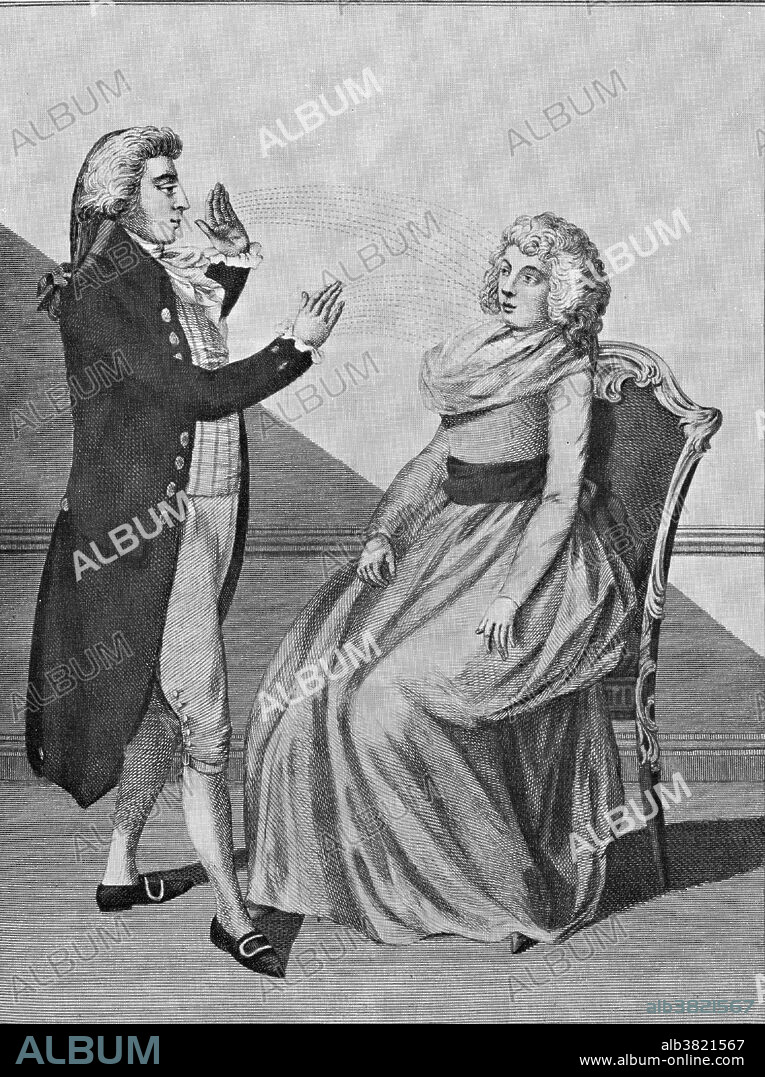alb3821567
Franz Mesmer, German Physician

|
Añadir a otro lightbox |
|
Añadir a otro lightbox |



¿Ya tienes cuenta? Iniciar sesión
¿No tienes cuenta? Regístrate
Compra esta imagen.
Selecciona el uso:

Título:
Franz Mesmer, German Physician
Descripción:
Traducción automática: Mesmer hipnotizando a un paciente. Franz Friedrich Anton Mesmer (23 de mayo de 1734 - 5 de marzo de 1815) fue un médico alemán interesado en la astronomía, que teorizó que existía una transferencia energética natural que se producía entre todos los objetos animados e inanimados a la que llamó magnetismo animal, a veces más tarde denominada mesmerismo. El mesmerismo se considera una forma de vitalismo y comparte características con otras teorías vitalistas que enfatizan el movimiento de la "energía" vital a través de distintos canales en el cuerpo. Hubo quienes pensaron que era un charlatán y otros que creían que había hecho un gran descubrimiento. Mesmer intentó, sin éxito, que la Real Academia de Ciencias o la Real Sociedad de Medicina otorgaran la aprobación oficial a sus doctrinas. En 1779, escribió un libro de 88 páginas titulado: Mémoire sur la découverte du magnetétisme animal, al que adjuntó sus famosas 27 Proposiciones que describían su teoría. En 1784, el rey Luis XVI designó a una comisión para que investigara el magnetismo animal. La comisión concluyó que no había pruebas de "mesmerismo" y que cualquier beneficio que produjera el tratamiento se atribuía a la "imaginación". Mesmer vivió hasta los 80 años.
Mesmer hypnotizing a patient. Franz Friedrich Anton Mesmer (May 23, 1734 - March 5, 1815) was a German physician with an interest in astronomy, who theorized that there was a natural energetic transference that occurred between all animated and inanimate objects that he called animal magnetism, sometimes later referred to as mesmerism. Mesmerism is considered to be a form of vitalism and shares features with other vitalist theories that emphasize the movement of life "energy" through distinct channels in the body. There were those who thought he was a charlatan and others who believed he had made a great discovery. Mesmer tried and failed to get either the Royal Academy of Sciences or the Royal Society of Medicine to provide official approval for his doctrines. In 1779, he wrote an 88-page book entitled: Mémoire sur la découverte du magnétisme animal, to which he appended his famous 27 Propositions that outlined his theory. In 1784 King Louis XVI appointed commissioners to investigate animal magnetism. The commission concluded that there was no evidence for "mesmerism" and whatever benefit the treatment produced was attributed to "imagination". Mesmer lived to be 80 years old.
Crédito:
Album / Science Source
Autorizaciones:
Modelo: No - Propiedad: No
¿Preguntas relacionadas con los derechos?
¿Preguntas relacionadas con los derechos?
Tamaño imagen:
3454 x 4623 px | 45.7 MB
Tamaño impresión:
29.2 x 39.1 cm | 11.5 x 15.4 in (300 dpi)
Palabras clave:
1815 • ALEMAN • ALEMANA • ALEMANES • ARTE • BLANCO Y NEGRO • CHARLATAN • CIENCIA • CURANDERO • DIBUJO • EUROPEA • EUROPEAS • EUROPEO • EUROPEOS • FAMOSA • FAMOSO • FIGURA • GENTE • HIPNOSIS • HISTORIA • HISTORICO • HOMBRE • HOMBRES • ILUSTRACION • IMPORTANTE • MASCULINO • OBRA DE ARTE • PERSONA • PERSONALIDAD • PERSONALIDADES • RETRATO DE HOMBRE • S. XVIII • SIGLO XIX • SIGLO XVIII
 Pinterest
Pinterest Twitter
Twitter Facebook
Facebook Copiar enlace
Copiar enlace Email
Email
